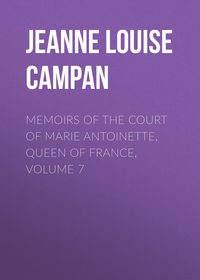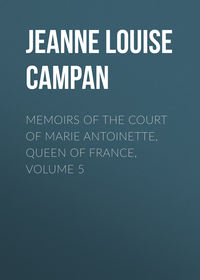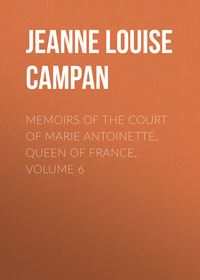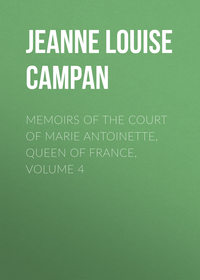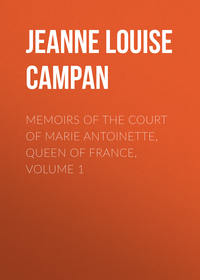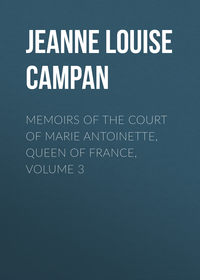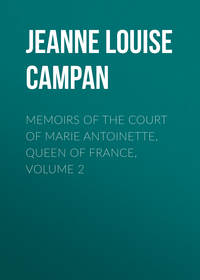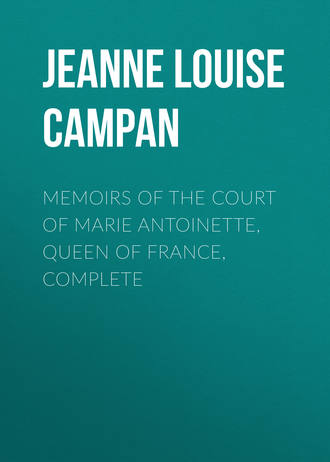 полная версия
полная версияПолная версия
Memoirs of the Court of Marie Antoinette, Queen of France, Complete
A small detachment of the troops of the line from the garrison of Paris, sent by the authorities, was waiting to serve as an escort. The bier, still covered with the pall, was carried on a litter on the shoulders of four men, who relieved each other two at a time; it was preceded by six or eight men, headed by a sergeant. The procession was accompanied a long way by the crowd, and a great number of persona followed it even to the cemetery. The name of “Little Capet,” and the more popular title of Dauphin, spread from lip to lip, with exclamations of pity and compassion. The funeral entered the cemetery of Ste. Marguerite, not by the church, as some accounts assert, but by the old gate of the cemetery. The interment was made in the corner, on the left, at a distance of eight or nine feet from the enclosure wall, and at an equal distance from a small house, which subsequently served as a school. The grave was filled up,—no mound marked its place, and not even a trace remained of the interment! Not till then did the commissaries of police and the municipality withdraw, and enter the house opposite the church to draw up the declaration of interment. It was nearly nine o’clock, and still daylight.
Release of Madame Royale.—Her Marriage to the Duc d’Angouleme. —Return to France.—DeathThe last person to hear of the sad events in the Temple was the one for whom they had the deepest and most painful interest. After her brother’s death the captivity of Madame Royale was much lightened. She was allowed to walk in the Temple gardens, and to receive visits from some ladies of the old Court, and from Madame de Chantereine, who at last, after several times evading her questions, ventured cautiously to tell her of the deaths of her mother, aunt, and brother. Madame Royale wept bitterly, but had much difficulty in expressing her feelings. “She spoke so confusedly,” says Madame de la Ramiere in a letter to Madame de Verneuil, “that it was difficult to understand her. It took her more than a month’s reading aloud, with careful study of pronunciation, to make herself intelligible,—so much had she lost the power of expression.” She was dressed with plainness amounting to poverty, and her hands were disfigured by exposure to cold and by the menial work she had been so long accustomed to do for herself, and which it was difficult to persuade her to leave off. When urged to accept the services of an attendant, she replied, with a sad prevision of the vicissitudes of her future life, that she did not like to form a habit which she might have again to abandon. She suffered herself, however, to be persuaded gradually to modify her recluse and ascetic habits. It was well she did so, as a preparation for the great changes about to follow.
Nine days after the death of her brother, the city of Orleans interceded for the daughter of Louis XVI., and sent deputies to the Convention to pray for her deliverance and restoration to her family. Names followed this example; and Charette, on the part of the Vendeans, demanded, as a condition of the pacification of La Vendee, that the Princess should be allowed to join her relations. At length the Convention decreed that Madame Royale should be exchanged with Austria for the representatives and ministers whom Dumouriez had given up to the Prince of Cobourg,—Drouet, Semonville, Maret, and other prisoners of importance. At midnight on 19th December, 1795, which was her birthday, the Princess was released from prison, the Minister of the Interior, M. Benezech, to avoid attracting public attention and possible disturbance, conducting her on foot from the Temple to a neighbouring street, where his carriage awaited her. She made it her particular request that Gomin, who had been so devoted to her brother, should be the commissary appointed to accompany her to the frontier; Madame de Soucy, formerly under-governess to the children of France, was also in attendance; and the Princess took with her a dog named Coco, which had belonged to Louis XVI.
[The mention of the little dog taken from the Temple by Madame Royale reminds me how fond all the family were of these creatures. Each Princess kept a different kind. Mesdames had beautiful spaniels; little grayhounds were preferred by Madame Elisabeth. Louis XVI. was the only one of all his family who had no dogs in his room. I remember one day waiting in the great gallery for the King’s retiring, when he entered with all his family and the whole pack, who were escorting him. All at once all the dogs began to bark, one louder than another, and ran away, passing like ghosts along those great dark rooms, which rang with their hoarse cries. The Princesses shouting, calling them, running everywhere after them, completed a ridiculous spectacle, which made those august persons very merry.—D’HEZECQUES, p. 49.]
She was frequently recognised on her way through France, and always with marks of pleasure and respect.
It might have been supposed that the Princess would rejoice to leave behind her the country which had been the scene of so many horrors and such bitter suffering. But it was her birthplace, and it held the graves of all she loved; and as she crossed the frontier she said to those around her, “I leave France with regret, for I shall never cease to consider it my country.” She arrived in Vienna on 9th January, 1796, and her first care was to attend a memorial service for her murdered relatives. After many weeks of close retirement she occasionally began to appear in public, and people looked with interest at the pale, grave, slender girl of seventeen, dressed in the deepest mourning, over whose young head such terrible storms had swept. The Emperor wished her to marry the Archduke Charles of Austria, but her father and mother had, even in the cradle, destined her hand for her cousin, the Duc d’Angouleme, son of the Comte d’Artois, and the memory of their lightest wish was law to her.
Her quiet determination entailed anger and opposition amounting to persecution. Every effort was made to alienate her from her French relations. She was urged to claim Provence, which had become her own if Louis XVIII. was to be considered King of France. A pressure of opinion was brought to bear upon her which might well have overawed so young a girl. “I was sent for to the Emperor’s cabinet,” she writes, “where I found the imperial family assembled. The ministers and chief imperial counsellors were also present . . . . When the Emperor invited me to express my opinion, I answered that to be able to treat fittingly of such interests I thought, I ought to be surrounded not only by my mother’s relatives, but also by those of my father . . . . Besides, I said, I was above all things French, and in entire subjection to the laws of France, which had rendered me alternately the subject of the King my father, the King my brother, and the King my uncle, and that I would yield obedience to the latter, whatever might be his commands. This declaration appeared very much to dissatisfy all who were present, and when they observed that I was not to be shaken, they declared that my right being independent of my will, my resistance would not be the slightest obstacle to the measures they might deem it necessary to adopt for the preservation of my interests.”
In their anxiety to make a German princess of Marie Therese, her imperial relations suppressed her French title as much as possible. When, with some difficulty, the Duc de Grammont succeeded in obtaining an audience of her, and used the familiar form of address, she smiled faintly, and bade him beware. “Call me Madame de Bretagne, or de Bourgogne, or de Lorraine,” she said, “for here I am so identified with these provinces—[which the Emperor wished her to claim from her uncle Louis XVIII.]—that I shall end in believing in my own transformation.” After these discussions she was so closely watched, and so many restraints were imposed upon her, that she was scarcely less a prisoner than in the old days of the Temple, though her cage was this time gilded. Rescue, however, was at hand.
In 1798 Louis XVIII. accepted a refuge offered to him at Mittau by the Czar Paul, who had promised that he would grant his guest’s first request, whatever it might be. Louis begged the Czar to use his influence with the Court of Vienna to allow his niece to join him. “Monsieur, my brother,” was Paul’s answer, “Madame Royale shall be restored to you, or I shall cease to be Paul I.” Next morning the Czar despatched a courier to Vienna with a demand for the Princess, so energetically worded that refusal must have been followed by war. Accordingly, in May, 1799, Madame Royale was allowed to leave the capital which she had found so uncongenial an asylum.
In the old ducal castle of Mittau, the capital of Courland, Louis XVIII. and his wife, with their nephews, the Ducs d’Angouleme and de Berri, were awaiting her, attended by the Abbe Edgeworth, as chief ecclesiastic, and a little Court of refugee nobles and officers.
[The Duc d’Angonleme was quiet and reserved. He loved hunting as means of killing time; was given to early hours and innocent pleasures. He was a gentleman, and brave as became one. He had not the “gentlemanly vices” of his brother, and was all the better for it. He was ill educated, but had natural good sense, and would have passed for having more than that had he cared to put forth pretensions. Of all his family he was the one most ill spoken of, and least deserving of it.—DOCTOR DORAN.]
With them were two men of humbler position, who must have been even more welcome to Madame Royale,—De Malden, who had acted as courier to Louis XVI. during the flight to Varennes, and Turgi, who had waited on the Princesses in the Temple. It was a sad meeting, though so long anxiously desired, and it was followed on 10th June, 1799, by an equally sad wedding,—exiles, pensioners on the bounty of the Russian monarch, fulfilling an engagement founded, not on personal preference, but on family policy and reverence for the wishes of the dead, the bride and bridegroom had small cause for rejoicing. During the eighteen months of tranquil seclusion which followed her marriage, the favourite occupation of the Duchess was visiting and relieving the poor. In January, 1801, the Czar Paul, in compliance with the demand of Napoleon, who was just then the object of his capricious enthusiasm, ordered the French royal family to leave Mittau. Their wanderings commenced on the 21st, a day of bitter memories; and the young Duchess led the King to his carriage through a crowd of men, women, and children, whose tears and blessings attended them on their way.
[The Queen was too ill to travel. The Duc d’Angouleme took another route to join a body of French gentlemen in arms for the Legitimist cause.]
The exiles asked permission from the King of Prussia to settle in his dominions, and while awaiting his answer at Munich they were painfully surprised by the entrance of five old soldiers of noble birth, part of the body-guard they had left behind at Mittau, relying on the protection of Paul. The “mad Czar” had decreed their immediate expulsion, and, penniless and almost starving, they made their way to Louis XVIII. All the money the royal family possessed was bestowed on these faithful servants, who came to them in detachments for relief, and then the Duchess offered her diamonds to the Danish consul for an advance of two thousand ducats, saying she pledged her property “that in our common distress it may be rendered of real use to my uncle, his faithful servants, and myself.” The Duchess’s consistent and unselfish kindness procured her from the King, and those about him who knew her best, the name of “our angel.”
Warsaw was for a brief time the resting-place of the wanderers, but there they were disturbed in 1803 by Napoleon’s attempt to threaten and bribe Louis XVIII. into abdication. It was suggested that refusal might bring upon them expulsion from Prussia. “We are accustomed to suffering,” was the King’s answer, “and we do not dread poverty. I would, trusting in God, seek another asylum.” In 1808, after many changes of scene, this asylum was sought in England, Gosfield Hall, Essex, being placed at their disposal by the Marquis of Buckingham. From Gosfield, the King moved to Hartwell Hall, a fine old Elizabethan mansion rented from Sir George Lee for L 500 a year. A yearly grant of L 24,000 was made to the exiled family by the British Government, out of which a hundred and forty persons were supported, the royal dinner-party generally numbering two dozen.
At Hartwell, as in her other homes, the Duchess was most popular amongst the poor. In general society she was cold and reserved, and she disliked the notice of strangers. In March, 1814, the royalist successes at Bordeaux paved the way for the restoration of royalty in France, and amidst general sympathy and congratulation, with the Prince Regent himself to wish them good fortune, the King, the Duchess, and their suite left Hartwell in April, 1814. The return to France was as triumphant as a somewhat half-hearted and doubtful enthusiasm could make it, and most of such cordiality as there was fell to the share of the Duchess. As she passed to Notre-Dame in May, 1814, on entering Paris, she was vociferously greeted. The feeling of loyalty, however, was not much longer-lived than the applause by which it was expressed; the Duchess had scarcely effected one of the strongest wishes of her heart,—the identification of what remained of her parents’ bodies, and the magnificent ceremony with which they were removed from the cemetery of the Madeleine to the Abbey of St. Denis,—when the escape of Napoleon from Elba in February,1815, scattered the royal family and their followers like chaff before the wind. The Duc d’Angouleme, compelled to capitulate at Toulouse, sailed from Cette in a Swedish vessel. The Comte d’Artois, the Duc de Berri, and the Prince de Conde withdrew beyond the frontier. The King fled from the capital. The Duchesse d’Angouleme, then at Bordeaux celebrating the anniversary of the Proclamation of Louis XVIII., alone of all her family made any stand against the general panic. Day after day she mounted her horse and reviewed the National Guard. She made personal and even passionate appeals to the officers and men, standing firm, and prevailing on a handful of soldiers to remain by her, even when the imperialist troops were on the other side of the river and their cannon were directed against the square where the Duchess was reviewing her scanty followers.
[“It was the Duchesse d’Angouleme who saved you,” said the gallant General Clauzel, after these events, to a royalist volunteer; “I could not bring myself to order such a woman to be fired upon, at the moment when she was providing material for the noblest page in her history.”—“Fillia Dolorosa,” vol. vii., p. 131.]
With pain and difficulty she was convinced that resistance was vain; Napoleon’s banner soon floated over Bordeaux; the Duchess issued a farewell proclamation to her “brave Bordelais,” and on the 1st April, 1815, she started for Pouillac, whence she embarked for Spain. During a brief visit to England she heard that the reign of a hundred days was over, and the 27th of July, 1815, saw her second triumphal return to the Tuileries. She did not take up her abode there with any wish for State ceremonies or Court gaieties. Her life was as secluded as her position would allow. Her favourite retreat was the Pavilion, which had been inhabited by her mother, and in her little oratory she collected relics of her family, over which on the anniversaries of their deaths she wept and prayed. In her daily drives through Paris she scrupulously avoided the spot on which they had suffered; and the memory of the past seemed to rule all her sad and self-denying life, both in what she did and what she refrained from doing.
[She was so methodical and economical, though liberal in her charities, that one of her regular evening occupations was to tear off the seals from the letters she had received during the day, in order that the wax might be melted down and sold; the produce made one poor family “passing rich with forty pounds a year.”—See “Filia Dolorosa,” vol. ii., p. 239.]
Her somewhat austere goodness was not of a nature to make her popular. The few who really understood her loved her, but the majority of her pleasure-seeking subjects regarded her either with ridicule or dread. She is said to have taken no part in politics, and to have exerted no influence in public affairs, but her sympathies were well known, and “the very word liberty made her shudder;” like Madame Roland, she had seen “so many crimes perpetrated under that name.”
The claims of three pretended Dauphins—Hervagault, the son of the tailor of St. Lo; Bruneau, son of the shoemaker of Vergin; and Naundorf or Norndorff, the watchmaker somewhat troubled her peace, but never for a moment obtained her sanction. Of the many other pseudo-Dauphins (said to number a dozen and a half) not even the names remain. In February,1820, a fresh tragedy befell the royal family in the assassination of the Duc de Berri, brother-in-law of the Duchesse d’Angouleme, as he was seeing his wife into her carriage at the door of the Opera-house. He was carried into the theatre, and there the dying Prince and his wife were joined by the Duchess, who remained till he breathed his last, and was present when he, too, was laid in the Abbey of St. Denis. She was present also when his son, the Duc de Bordeaux, was born, and hoped that she saw in him a guarantee for the stability of royalty in France. In September, 1824, she stood by the death-bed of Louis XVIII., and thenceforward her chief occupation was directing the education of the little Duc de Bordeaux, who generally resided with her at Villeneuve l’Etang, her country house near St. Cloud. Thence she went in July, 1830, to the Baths of Vichy, stopping at Dijon on her way to Paris, and visiting the theatre on the evening of the 27th. She was received with “a roar of execrations and seditious cries,” and knew only too well what they signified. She instantly left the theatre and proceeded to Tonnere, where she received news of the rising in Paris, and, quitting the town by night, was driven to Joigny with three attendants. Soon after leaving that place it was thought more prudent that the party should separate and proceed on foot, and the Duchess and M. de Foucigny, disguised as peasants, entered Versailles arm-in-arm, to obtain tidings of the King. The Duchess found him at Rambouillet with her husband, the Dauphin, and the King met her with a request for “pardon,” being fully conscious, too late, that his unwise decrees and his headlong flight had destroyed the last hopes of his family. The act of abdication followed, by which the prospect of royalty passed from the Dauphin and his wife, as well as from Charles X.—Henri V. being proclaimed King, and the Duc d’Orleans (who refused to take the boy monarch under his personal protection) lieutenant-general of the kingdom.
Then began the Duchess’s third expatriation. At Cherbourg the royal family, accompanied by the little King without a kingdom, embarked in the ‘Great Britain’, which stood out to sea. The Duchess, remaining on deck for a last look at the coast of France, noticed a brig which kept, she thought, suspiciously near them.
“Who commands that vessel?” she inquired.
“Captain Thibault.”
And what are his orders?”
“To fire into and sink the vessels in which we sail, should any attempt be made to return to France.”
Such was the farewell of their subjects to the House of Bourbon. The fugitives landed at Weymouth; the Duchesse d’Angouleme under the title of Comtesse de Marne, the Duchesse de Berri as Comtesse de Rosny, and her son, Henri de Bordeaux, as Comte de Chambord, the title he retained till his death, originally taken from the estate presented to him in infancy by his enthusiastic people. Holyrood, with its royal and gloomy associations, was their appointed dwelling. The Duc and Duchesse d’Angouleme, and the daughter of the Duc de Berri, travelled thither by land, the King and the young Comte de Chambord by sea. “I prefer my route to that of my sister,” observed the latter, “because I shall see the coast of France again, and she will not.”
The French Government soon complained that at Holyrood the exiles were still too near their native land, and accordingly, in 1832, Charles X., with his son and grandson, left Scotland for Hamburg, while the Duchesse d’Angouleme and her niece repaired to Vienna. The family were reunited at Prague in 1833, where the birthday of the Comte de Chambord was celebrated with some pomp and rejoicing, many Legitimists flocking thither to congratulate him on attaining the age of thirteen, which the old law of monarchical France had fixed as the majority of her princes. Three years later the wanderings of the unfortunate family recommenced; the Emperor Francis II. was dead, and his successor, Ferdinand, must visit Prague to be crowned, and Charles X. feared that the presence of a discrowned monarch might be embarrassing on such an occasion. Illness and sorrow attended the exiles on their new journey, and a few months after they were established in the Chateau of Graffenburg at Goritz, Charles X. died of cholera, in his eightieth year. At Goritz, also, on the 31st May, 1844, the Duchesse d’Angouleme, who had sat beside so many death-beds, watched over that of her husband. Theirs had not been a marriage of affection in youth, but they respected each other’s virtues, and to a great extent shared each other’s tastes; banishment and suffering had united them very closely, and of late years they had been almost inseparable,—walking, riding, and reading together. When the Duchesse d’Angouleme had seen her husband laid by his father’s side in the vault of the Franciscan convent, she, accompanied by her nephew and niece, removed to Frohsdorf, where they spent seven tranquil years. Here she was addressed as “Queen” by her household for the first time in her life, but she herself always recognised Henri, Comte de Chambord, as her sovereign. The Duchess lived to see the overthrow of Louis Philippe, the usurper of the inheritance of her family. Her last attempt to exert herself was a characteristic one. She tried to rise from a sick-bed in order to attend the memorial service held for her mother, Marie Antoinette, on the 16th October, the anniversary of her execution. But her strength was not equal to the task; on the 19th she expired, with her hand in that of the Comte de Chambord, and on 28th October, 1851, Marie Therese Charlotte, Duchesse d’Angouleme, was buried in the Franciscan convent.
The Ceremony of Expiation“In the spring of 1814 a ceremony took place in Paris at which I was present because there was nothing in it that could be mortifying to a French heart. The death of Louis XVI. had long been admitted to be one of the most serious misfortunes of the Revolution. The Emperor Napoleon never spoke of that sovereign but in terms of the highest respect, and always prefixed the epithet unfortunate to his name. The ceremony to which I allude was proposed by the Emperor of Russia and the King of Prussia. It consisted of a kind of expiation and purification of the spot on which Louis XVI. and his Queen were beheaded. I went to see the ceremony, and I had a place at a window in the Hotel of Madame de Remusat, next to the Hotel de Crillon, and what was termed the Hotel de Courlande.
“The expiation took place on the 10th of April. The weather was extremely fine and warm for the season. The Emperor of Russia and King of Prussia, accompanied by Prince Schwartzenberg, took their station at the entrance of the Rue Royale; the King of Prussia being on the right of the Emperor Alexander, and Prince Schwartzenberg on his left. There was a long parade, during which the Russian, Prussian and Austrian military bands vied with each other in playing the air, ‘Vive Henri IV.!’ The cavalry defiled past, and then withdrew into the Champs Elysees; but the infantry ranged themselves round an altar which was raised in the middle of the Place, and which was elevated on a platform having twelve or fifteen steps. The Emperor of Russia alighted from his horse, and, followed by the King of Prussia, the Grand Duke Constantine, Lord Cathcart, and Prince Schwartzenberg, advanced to the altar. When the Emperor had nearly reached the altar the “Te Deum” commenced. At the moment of the benediction, the sovereigns and persons who accompanied them, as well as the twenty-five thousand troops who covered the Place, all knelt down. The Greek priest presented the cross to the Emperor Alexander, who kissed it; his example was followed by the individuals who accompanied him, though they were not of the Greek faith. On rising, the Grand Duke Constantine took off his hat, and immediately salvoes of artillery were heard.”




